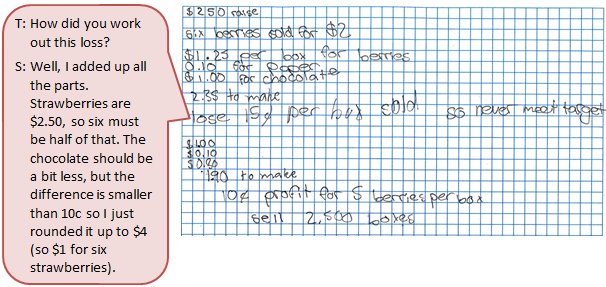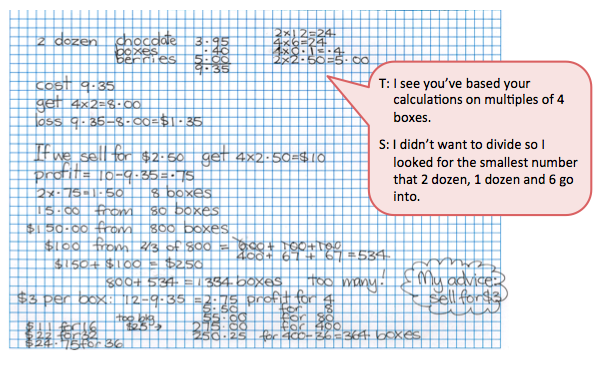The purpose of this activity is to engage students in solving a financial problem using decimal arithmetic techniques.
This activity assumes the students have experience in the following areas:
- Solving problems with amounts of money.
- Developing budgets for households and projects.
- Adding and subtracting decimals.
- Calculating profit and loss.
The problem is sufficiently open ended to allow the students freedom of choice in their approach. It may be scaffolded with guidance that leads to a solution, and/or the students might be given the opportunity to solve the problem independently.
The example responses at the end of the resource give an indication of the kind of response to expect from students who approach the problem in particular ways.

A year 8 class is making a fundraising stall for the school fair.
They have decided to make chocolate coated strawberries in white, dark and milk chocolate and to present these in boxes made from origami.
The goal is to raise at least $250 for the school. They plan to sell boxes of six strawberries for $2.
The local supermarket sells punnets of a dozen strawberries for $2.50, and cooking chocolate for $3.95 per bag.
A bag of chocolate should be enough to coat two dozen strawberries.
The boxes take one sheet of coloured paper (10 cents) to make.
Is this plan going to work?
How could it be modified to make this fundraising goal realistic?
The following prompts illustrate how this activity can be structured around the phases of the Mathematics Investigation Cycle.
Make sense
Introduce the problem. Allow students time to read it and discuss in pairs or small groups.
- Do I understand the situation and the words? (Students may not be familiar with profit and how it is the difference between income and cost.)
- Is all the information needed available to you?
- How are budgets usually created in real life?
- What will my solution look like? (The solution will be a decision about whether, or not, the fund-raiser will make money and justification for that decision.)
Plan approach
Discuss ideas about how to solve the problem. Emphasise that, in the planning phase, you want students to say how they would solve the problem, not to actually solve it.
- What strategies can I use to get started? (A table format helps to organise the budget calculations.)
- How will I work out the cost of each ingredient? Will I work out that cost per pack or per number of packs?
- How will I need to adjust the ingredient amounts to match my costing?
- Do I have a sense of the likely solution?
- What tools will I use? (A spreadsheet is an obvious tool to use.)
Take action
Allow students time to work through their strategy and find a solution to the problem.
- Am I recording my workings in a systematic way so others could follow them?
- Does my answer seem correct? Does the budget look sound and all the cost are included?
- Have I worked out each cost per strawberry, pack, number of packs correctly? How can I check?
- How does my answer match my original prediction? If not, is there reason to revisit my calculations?
- Is there another possible answer or way to solve it? Can I be more efficient?
Convince yourself and others
Allow students time to check their answers and then either have them pair share with other groups or ask for volunteers to share their solution with the class.
- What is the solution? Can I show that the solution is correct? How?
- Is my working clear for someone else to follow?
- How would I convince someone else I am correct?
- Could I have solved the problem in a more efficient way? How?
- How might I change the fundraiser, so it is profitable? (Consider both costs and pricing.)
- What could I try differently next time, with a similar problem?
Examples of work
Work sample 1
The student creates a list that includes each item and calculates the per packet cost. They sensibly conclude the pricing does not provide a profit.
Click on the image to enlarge it. Click again to close. 
Work sample 2
The student creates an itemised list of costs and calculates the per packet cost. They suggest how the product can be adapted to make a profit.
Click on the image to enlarge it. Click again to close. 
Work sample 3
The student creates an itemised list of costs and calculates the per packet cost. They suggest how the product can be adapted to make a profit.
